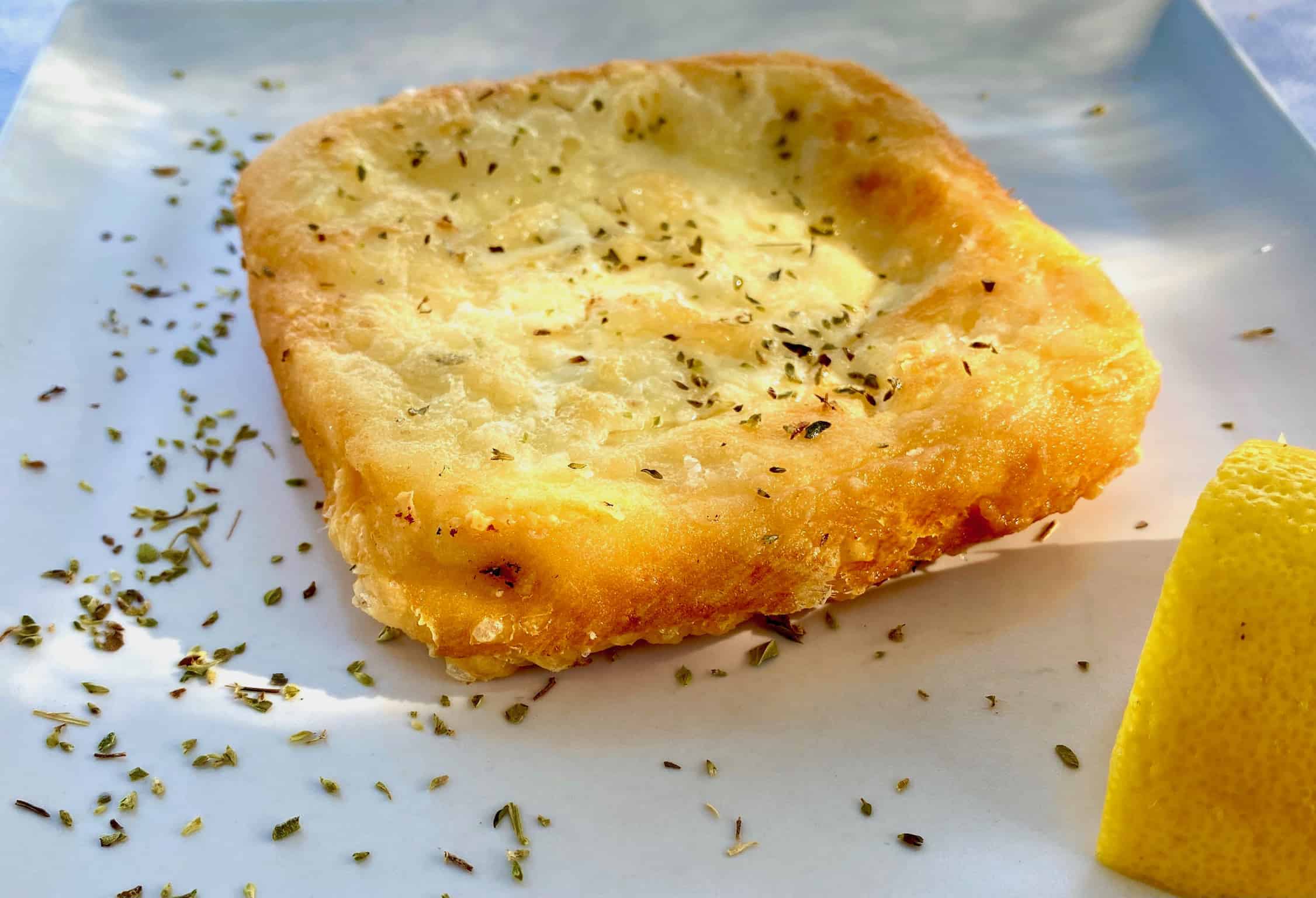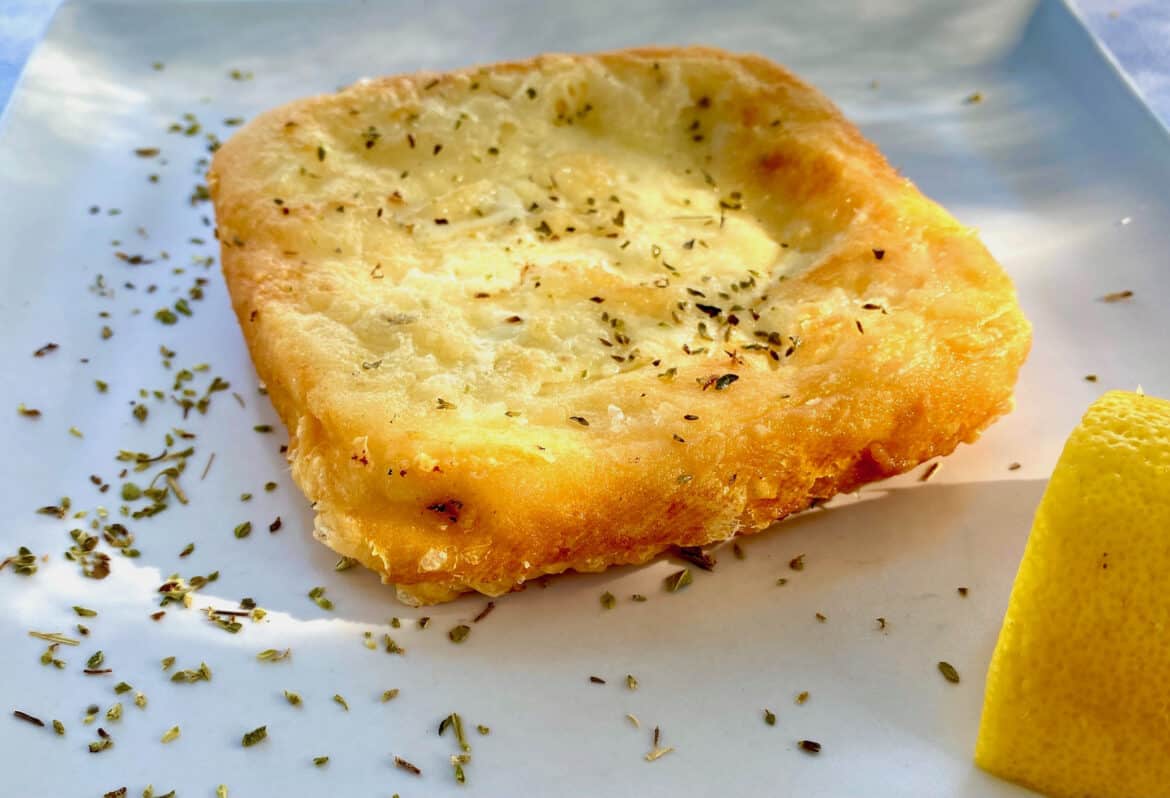Prepare a delectable Greek gooey cheesy appetiser with this Greek Cheese Saganaki recipe ( Greek pan fried cheese) at home.

What is Greek Cheese Saganaki?
Cheese Saganaki is a beloved Greek dish (appetiser) that features pan-fried cheese, resulting in a deliciously golden-brown crust. This popular appetizer can often be found on the menus of Greek restaurants, and it showcases the rich flavors of Greek cheeses such as halloumi and other firm varieties. Served hot and sizzling, the saganaki cheese is typically accompanied by lemon wedges and crusty bread for dipping.
The process of making saganaki involves coating slices of cheese in flour and frying them in a skillet over medium-high heat until a crispy crust forms. Lemon juice or cold water may be added to the skillet to create a flavorful steam, which enhances the texture and taste of the cheese.
Benefits of Greek Cheese Saganaki Recipe
The Greek Cheese Saganaki recipe is a traditional starter in Greek cuisine that is loved for its delicious flavours and crispy golden-brown crust. Saganaki is made with a variety of Greek cheeses, which gives it a rich and savory taste. The cheese slices are pan-fried to perfection, creating a crunchy and golden crust that is truly irresistible.
One of the benefits of the Greek Saganaki recipe is its versatility. There are several types of Greek cheeses that can be used, including the popular salty cheese, halloumi, and other yellow cheeses. This allows you to experiment with different flavors and textures, creating a unique dish every time.
Tips for perfect Greek Cheese Saganaki Recipe ( Greek pan fried cheese)
Cheese
You will be wondering what kind of cheese is Greek Cheese Saganaki made of. Well, when it comes to making the perfect Greek Saganaki, choosing the right cheese is crucial. Greek Cheese Saganaki is made of from and flavourful cheeses that can hold their shape when fried.
The traditional Greek cheeses, such as kefalotiri ( Kefalotyri) , Graver, Halloumi or manouri cheese, work exceptionally well for this dish. These firm and salty cheeses are ideal for pan-frying and create a delicious golden crust whilst maintaining a gooey interior.
Cheese preparation
To begin prepping the cheese, start by wetting the slice in cold water. This step is important as it helps the flour adhere better to the cheese and prevents it from becoming too dry during the cooking process.
Once cheese is flour coated, gently shake off any excess flour from the cheese slice. This is essential as too much flour can create a heavy coating and affect the overall texture of the dish.
Repeat the process twice for extra crunch in you Saganaki.
Frying
To make the perfect Saganaki, heat a tablespoon of olive oil in an iron skillet over medium-high heat. Dip each slice of cheese in flour, making sure to shake off any excess. Place the cheese slices in the hot skillet and cook for about 2-3 minutes on each side, or until a golden crust forms. Squeeze fresh lemon juice over the cheese and serve immediately.
Oil versus butter for Cheese Saganaki frying
When it comes to frying Greek saganaki, choosing the right oil or butter is crucial to achieve the perfect flavor and texture. The type of fat you use can make all the difference in creating that golden brown, crispy crust that is characteristic of this delicious dish.
For a traditional taste, Greek olive oil is the go-to option. Its distinct flavor adds a subtle yet distinct Mediterranean touch to the saganaki. Extra virgin olive oil is particularly recommended for its rich taste and high smoking point, which allows for frying at medium-high heat without burning the cheese.
If you prefer a milder flavour, you can opt for a neutral oil like vegetable or canola oil. These oils have a higher smoking point, making them suitable for frying at medium heat.
For those who want to add an extra layer of richness to their saganaki, using butter is an excellent choice. Butter brings a creamy and indulgent flavor to the dish.
Ultimately, the choice between oil and butter comes down to personal preference. Whether you decide to go with Greek olive oil for an authentic touch or use butter for its luxurious taste, make sure to heat them in a skillet over medium heat until hot before adding the cheese.
Remember, the oil or butter you choose can greatly impact the overall taste and texture of your saganaki. So, select your preferred option wisely and get ready to indulge in this delectable Greek appetizer.
Greek Cheese Saganaki Recipe ( Greek pan fried cheese) recipe preparation
The recipe for saganaki is easy to follow, and it requires just a few basic ingredients and simple steps. So let’s delve into the directions and get ready to enjoy this delightful Greek pan-fried cheese.
Preparing the Cheese
To start, prepare the cheese by slicing it into approximately 1/2-inch thick slices. It is recommended to use a firm cheese that is suitable for frying, such as halloumi or another solid, yellow cheese.
Next, coat the cheese slices or pieces in flour, making sure to shake off any excess flour. In a well-heated skillet, add a tablespoon of olive oil and place the floured cheese in the pan.
Cook the cheese over medium-high heat for about 2-3 minutes, or until a golden-brown crust forms. Flip the cheese carefully using a spatula and cook for an additional 2-3 minutes on the other side.
Once the cheese is nicely browned, remove it from the skillet and drain any excess oil on a paper towel. Squeeze fresh lemon juice over the cheese and garnish with oregano, parsley or thyme if desired.
Making the Batter
To make the batter for Greek Saganaki, you’ll need just two simple ingredients: flour and cold water. This batter is what gives the cheese slices their deliciously crispy, golden-brown crust.
To start, moisten each cheese slice with a bit of cold water. This helps the flour adhere to the cheese and create a perfectly crispy crust. Next, dredge the moistened cheese slices in flour, making sure to shake off any excess. The flour will form a light coating around the cheese, resulting in a beautiful golden-brown crust when fried. Repeat the process of water a flour of ran extra crunchy coating to your Saganaki.
The batter is crucial in achieving that signature texture and flavor of Saganaki. When the cheese is pan-fried with the flour coating, it transforms into a wonderfully crispy delight that pairs perfectly with a squeeze of fresh lemon juice.
So, don’t skip the batter step when making Greek Saganaki. It ensures that every bite of this heavenly dish is met with a satisfying crunch and the perfect balance of flavours.
Serving suggestions
Saganaki is typically served as a mezze dish, which means it is meant to be enjoyed as an appetizer or a snack. It is usually served with a squeeze of fresh lemon juice and accompanied by crusty bread, warm pita bread and a Greek Horiatiki salad. This combination of flavors creates a tantalizing taste experience that is sure to delight your taste buds.
Pair it with a glass of cold water, beer or Greek ouzo for an authentic Greek dining experience.
Cheesy Greek Appetisers
- Greek Feta wrapped in phyllo
- Mini Tiropitakia (Greek baked Feta cheese triangles)
- Feta cheese ball recipe
- Milinoudia (Greek mini pan fried Feta cheese pies)


1 comment
Very nice recipe chef 👍👌👏. Delicious 😋. Thank you for your effort 🌞😎